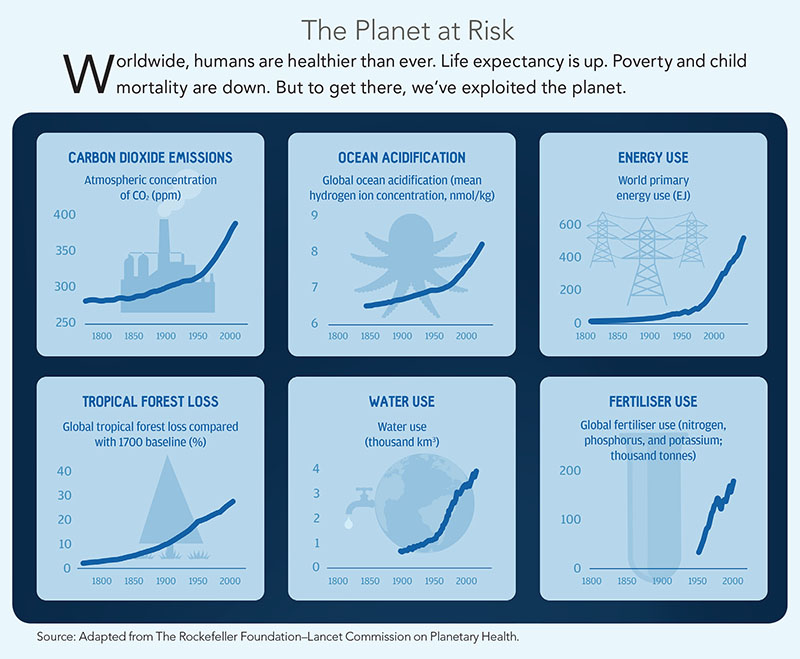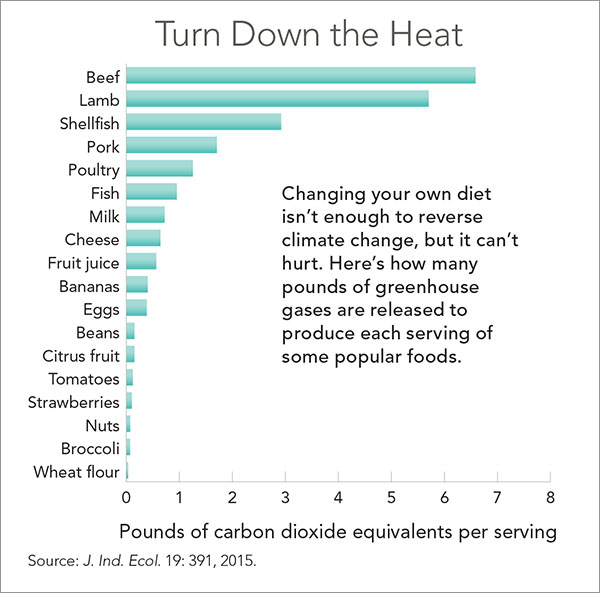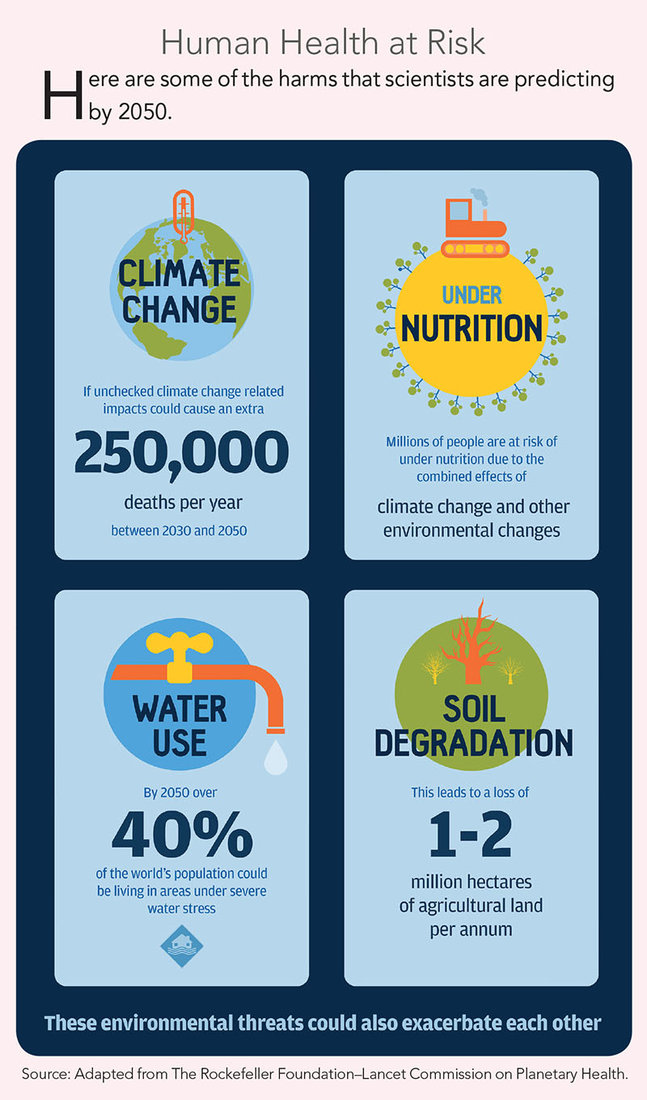There is no planet B: to protect our health, we have to protect the Earth

Destina - stock.adobe.com.
Humans are damaging the natural systems of the only planet we’ve got. Here’s how that puts our health—and our children’s health—at risk.

Sam Myers is a physician and principal research scientist at the Harvard T.H. Chan School of Public Health and the director of the Planetary Health Alliance. He serves on The Rockefeller Foundation-Lancet Commission on Planetary Health. Myers spoke with Nutrition Action’s Caitlin Dow.
A changing planet
Q:What is planetary health?
A: Humans are changing just about all the natural systems on the planet at an unprecedented rate. The field of planetary health examines the implications of those changes, not only for nature but for our own health.
Q:Which natural systems have we changed?
A: You name it. We’re disrupting the climate system. We’ve cleared half the tropical and temperate forests in the world. We’ve polluted air, water, and soil, and we can see it on a planetary scale. We’re driving species extinct at a thousand times the baseline rate. We’ve dammed more than 60 percent of the world’s rivers. What natural systems have we not fundamentally altered?
Q:Are these changes recent?
A: Yes. The biophysical conditions of the Holocene—the current geologic period that has lasted for roughly the past 12,000 years—have been extraordinarily stable. And suddenly, in the last 60 years or so, we are turning every dial, throwing every switch, pushing every button.
We’re completely changing the biophysical conditions that we have adapted to. It’s not surprising that the impact is going to be deleterious.
Q:What’s driving these changes?
A: First, there’s the almost exponential growth of the human population since the 1950s, when the population was about two billion. Now, it’s well over seven billion and rising very rapidly. Projections are on the order of 10 to 12 billion by the end of the century.
But it’s also because of even steeper growth in the amount of resources each person consumes. To feed ourselves, we use about 40 percent of the ice-free, desert-free land as pastures and croplands, and about half of the planet’s accessible water, largely to irrigate crops. And we exploit 90 percent of the world’s fisheries at or beyond their maximum sustainable limits.

Q:But haven’t we become healthier?
A: Yes. Worldwide, we’ve reduced poverty, increased life expectancy, and decreased child mortality. The problem is that it’s not sustainable. We’re mortgaging the health of future generations to make our lives better now.
We’re completely changing the playing field in terms of temperature, precipitation patterns, the biology of pollinators and pests and pathogens, the availability of arable land and fresh water, and biodiversity.
We’re changing those things at the fastest rates in the history of our species, just when we also need to increase food production at the fastest rate in the history of our species, thanks to the growing population and more wealth. That has allowed people to eat more animal foods, which require growing huge amounts of grain and soy to feed livestock.
Q:How will those changes harm our health?
A: Left unchecked, they will alter the quality of the air we breathe, the water we have access to, and the food we can produce. They will expose us to infectious diseases and natural hazards like heat waves, droughts, floods, fires, and tropical storms. We’re already seeing statistical increases in the incidence of those extreme weather events.
And if drought, rising sea levels, or extreme heat leads people to flee their homes and become refugees, that puts them at risk for malnutrition, infectious disease, and physical, sexual, and psychological trauma.
The civil war in Syria that has displaced millions of people, for example, was due in part to the worst three-year drought on record. Ultimately, those changes will affect every dimension of our health.
Q:How will the changes cause more infectious disease?
A: Warming temperatures and changes in precipitation and soil moisture may change the habitats, life cycles, and biting rates of insects that carry diseases like malaria, dengue fever, and Lyme disease.
Q:Will non-infectious diseases also increase?
A: Yes. For example, air pollution increases the risk of heart disease, stroke, lung cancer, and chronic obstructive pulmonary disease.
In Bangladesh, people are consuming excess salt loads because rising sea levels are moving saltwater into freshwater aquifers. The excess salt means high blood pressure in some people. And pregnant women are showing higher rates of pre-eclampsia, a high blood pressure disorder that can kill both the mother and the fetus.

The food supply
Q:How will changes in natural systems affect the food supply?
A: Obviously, extreme weather events have local effects. If your crops flood or are burned in a fire or wither in a heat wave, that affects yield. And rising sea levels will put low-lying fertile coastal areas at risk of flooding.
Q:What about the seafood supply?
A: We’re overfishing. Fish catch peaked in the 1990s and has been falling by 1 percent—about 1.2 million metric tons—per year since then, because overfishing has led to the collapse of fisheries.
Now, with warming ocean temperatures, we anticipate smaller fish and smaller fish populations. And we expect a dramatic redistribution of fisheries away from the tropics and toward the poles.
Q:Why is that a problem?
A: Most of the population growth we’re expecting is in developing countries, mostly in the tropics. So you get a bigger disconnect between where the people are and where the food is.
We’re also seeing ocean warming and acidification, which lead to massive coral bleaching events. We anticipate that most of our coral reefs will be destroyed by the end of the century. Reefs are nurseries for small fish that many people depend on for subsistence.
Q:Will the expected changes make some foods less nutritious?
A: Yes. In open field experiments, we grew identical crops inside and outside of rings of carbon-dioxide-emitting jets.
We looked at 41 cultivars of six staple crops in seven locations on three continents over ten years. We exposed the crops to about 550 parts per million of CO2, which is where we expect to be in the middle of this century.
At higher CO2 levels, we found significant reductions in iron and zinc in most of the staple food crops that we consume. We also found significant reductions in protein in staple grains like wheat and rice.
Q:Do those reductions matter?
A: Yes. About two and a half billion people get 70 percent or more of their zinc, iron, or protein from crops that are expected to lose those nutrients in response to rising CO2.
By mid-century, around 150 million people would become zinc deficient, 150 million people would also be pushed into protein deficiency, and zinc and protein deficiencies would be exacerbated in the billion people who are already deficient.
Rising CO2 would also exacerbate iron deficiency in enormous numbers of vulnerable women and children.

Q:What about fruits and vegetables?
A: Widespread declines in insect pollinators could reduce yields of fruits, vegetables, nuts, and seeds. Globally, that could increase the risks of heart disease, stroke, and certain cancers.
Q:What will happen to livestock?
A: We don’t know an awful lot yet, but the animals will be affected by water availability and heat stress. Plus, the plants available for animals to forage are likely to change.
Q:Who will be hurt the most?
A: The most vulnerable are poor people with few financial, institutional, or technological safety nets. In a perverse irony, it is the wealthiest nations whose consumption patterns and CO2 emissions are putting the poorest into harm’s way.
Wealthier nations are not immune to the health effects of planetary changes like more frequent natural disasters, changes in the quality of food, declines of fisheries and pollinators, and rising sea levels. But the wealthy are better insulated from the effects.
What to do
Q:What can we do to protect our children and grandchildren?
A: We need to expand the realm of public health to include how we manage our planet’s natural systems: how we feed ourselves, how we produce energy, the types of cities we construct, and how well we protect our biodiversity.
Then we need to exert pressure to change policies, despite powerful vested interests like fossil fuel companies and Big Agriculture. It will take time. It’s like steering a supertanker.
Q:What can individuals do?
A: It feels good to say “I’m a vegetarian and I bike to work, so that’s my contribution to solve the problem.” And those are good things to do. But they’re nowhere near enough.
We need to find each other, organize, and pressure our elected leaders to acknowledge that climate change is a grave threat to humanity and to take aggressive action to curb it.
For example, we can insist on a rapid transition away from fossil fuels and toward renewables to meet our energy needs.
There’s every reason to believe that we can rise to these challenges. We have extraordinary capacity for innovation. But we need to get to work.
Illustration (top): Destina/stock.adobe.com.
Topics

